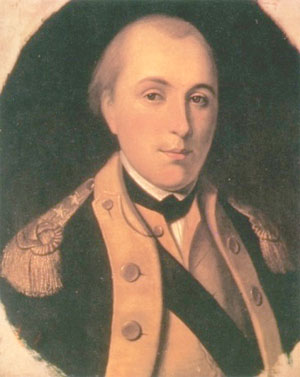The Marquis de Lafayette

by Charles Willson Peale, after life portrait
The Marquis de Lafayette was born in Chavaniac Auvergne, France on September 6th, 1757. He was baptized Marie, Joseph, Paul, Yves, Roch, Gilbert du Motier, Marquis du Lafayette, Baron de Vissac, Seigneur de St. Romain.
His father had died at the Battle of Minden in 1759 during the Seven Years War. In 1768, he moved to Paris with his mother, and entered the college du Plessis. Then, in 1770, Lafayette's mother and grandmother died in the same week. As a result, Lafayette inherited a great deal of wealth. The next year, he joined the Royal Army as a Sous-lieutenant in the Kimip Musketeers, and two years later, at age 16, he married the 14 year-old Marie Adrienne Francoise de Noalles, who came from one of the most powerful families in France in a pre-arranged marriage.
Later, he became interested in the American cause. In 1776, he signed an agreement with Silas Dean, the American Army Commissioner in Paris, to serve as a Major General in the Continental Army. The next year, Lafayette bought his own ship and sailed for America accompanied by Baron Johann de Kalb. They landed in South Carolina, and Lafayette arrived in Philadelphia at the end of July. On July 31st, he was commissioned a major general but was given no command.
After he recuperated from a wound he received at Brandywine for two months in Bethlehem, he rejoined the army. In December, he was given command of division of Virginia troops. He then fought at Monmouth in 1778 and then returned to France. In 1779, he returned to America with secret news that Rochambeau's forces would be sent to America. He commanded a third of the army during the Siege of Yorktown in 1781.
Two months later, he returned to France. Louis XVI appointed him as a member of the Assembly of Notables to advise on the financial crisis in 1787. Lafayette then called for a national assembly. In 1789, he was elected to Estates General from Auvergne and presented the first European Declaration of the Rights of Man and of Citizens. He was also named Commander of the Paris National Guard and given the title: "Hero of Two Worlds."
In 1790, Lafayette supported the decree abolishing titles of nobility and presided over the Fete de la Federation. Then, in 1791, Lafayette resigned his military post upon acceptance of the New Constitution. When France was at war with Prussia and Austria, he took command of the center army at the front. During the French Revolution in 1792, Jacobins under Robespierre attacked both the monarchy and Lafayette as a tool of the king. Louis XVI was deposed and the Assembly passed a bill of impeachment against Lafayette. Lafayette fled France and was captured and imprisoned by the Austrians in Olmutz. His wife, Adrienne, was arrested in France. In 1795, Adrienne was released from a French prison and joined her husband in Olmutz with their two daughters. Their son, George Washington Lafayette, was sent to America to live with General Washington.
Finally, in 1798, Napoleon arranged the release of Lafayette and his family. Lafayette returned to France in 1799 and moved to LaGrange Blenau. He voted against life consulship for Napoleon in 1802 and his wife died in 1808. In 1815, he was elected to the Chamber of Deputies during the Hundred Days War. After Waterloo, he proposed Napoleon's abdication, while threatening to overthrow him otherwise.
In 1824, he returned on a visit to the United States and visited all 24 states over a fourteen month period. After returning to France in 1830, he reestablished the National Guard and participated in the July revolution. Lafayette then accepted Louis Philipe as king after he promised a monarchy with republican institutions. He died on May 20, 1834 and was buried at the Picpus Cemetery in Paris.
Lafayette's daughter, Anastasia, was born in 1777 and in 1779, their son, George Washington Lafayette was born. In 1782, a daughter, Virginia, was born.


